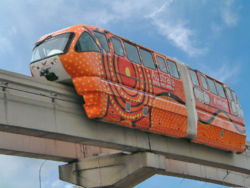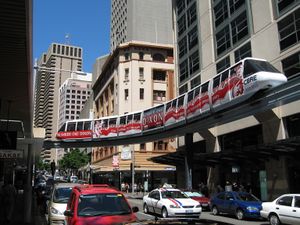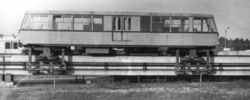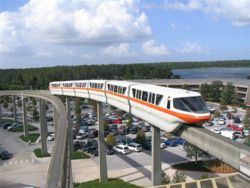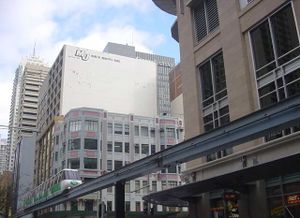Monorail
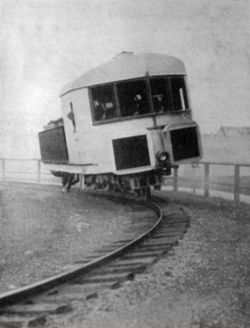
The term monorail or industrial monorail is used to describe any number of systems in which a chair or carrier is suspended from, or rides on, an overhead rail structure for the limited transportation of goods, passengers or workers.
Contents
Background
Attempts at creating unconventional railways have been made since the latter part of the 19th century. Usually these have been claimed to be more efficient, faster or cheaper to construct than conventional railways.
Several attempts have been made to create a system in which a double-flanged steel wheel operates on a single rail similar to the railroad type of rail. The Wuppertal monorail described below is the only surviving monorail of this type.
Monorails have both benefited and suffered from their novelty and concept of modernity. When The Walt Disney Company placed a monorail in their Disneyland theme park in 1959, it exposed large numbers of visitors to the transportation form in a credible though miniature transit setting. At the same time, however, the Disneyland monorail and others built at other Disney properties and amusement locations have tended to identify monorails with amusements rather than practical transportation.
The popular press in the U.S. in mid-20th-century often featured monorail ideas in a "transportation of the future" context but this same press also displayed images of personal "rocket backpacks" and popular space travel, creating interest but also confusion as to which ideas were fads and which might become reality.
Types and technical aspects
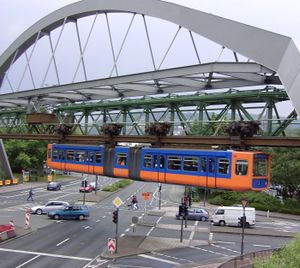
Modern monorails depend on a large solid beam as the vehicles' running surface. There are a number of competing designs divided into two broad classes, straddle-beam and suspended monorails.
The most common type of monorail in use today is the straddle-beam monorail, in which the train straddles a reinforced concrete beam in the range of two to three feet (~0.6-0.9 m) wide. A rubber-tired carriage contacts the beam on the top and both sides for traction and to stabilize the vehicle. The straddle-beam style was popularized by the German company ALWEG.
There is also a form of suspended monorail developed by the French company SAFEGE in which the train cars are suspended beneath the wheel carriage. In this design the carriage wheels ride inside the single beam.
Power
Almost all modern monorails are powered by electric motors fed by dual third rails, contact wires or electrified channels attached to or enclosed in their guidance beams. There is a startup called Metrail who have built a hybrid prototype using diesel power to generate electricity for the motors.
Magnetic levitation
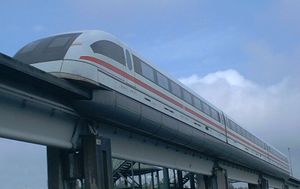
Magnetic levitation train (maglev) systems by the German Transrapid were built as straddle-type monorails, as they are highly stable and allow rapid deceleration from great speed. When in full-speed operation maglev trains actually hover over the track and are thus not in physical contact with it. It is the fastest monorail, running at up to 311 mph (501 kph).
Switching
Switching has been a perennial issue with monorail systems since simple switching mechanisms associated with other systems are usually not feasible. Some early monorail systems--notably the suspended monorail of Wuppertal (Germany), dating from 1901 and still in operation--have a design that makes it difficult to switch from one line to another. Some other monorail systems avoid switching as much as possible, by operating in a continuous loop or between two fixed stations, as in Seattle, Washington.
Current operating monorails are capable of more efficient switching than in the past. In the case of suspended monorails, switching may be accomplished by moving flanges inside the beamway to shift trains to one line or another.
Straddle-beam monorails require that the beam structure itself be moved to accomplish switching, which originally was an almost prohibitively ponderous procedure. Now, however, the most common way of achieving this is to place a moving apparatus on top of a sturdy platform capable of bearing the weight of vehicles, beams and its own mechanism. Multiple-segmented beams move into place on rollers to smoothly align one beam with another to send the train in its desired direction, with the design originally developed by ALWEG capable of completing a switch in 12 seconds[1]. Some of these beam turnouts are quite elaborate, capable of switching between several beams or even simulating a railroad double-crossover.
In cases where it must be possible to move a monorail train from one beam to any of a number of other beams, as in storage or repair shops, a traveling beam not unlike a railroad transfer table may be employed. A single beam, at least long enough to carry a single monorail vehicle, is aligned at an entry beam to be mounted by the monorail cars. The entire beam then rolls with the vehicle to align with the desired storage beam.
Systems similar in appearance
The term 'monorail' is often applied by members of the public to any modern elevated railway, particularly automated ones such as the Docklands Light Railway, Vancouver SkyTrain and the JFK AirTrain, but this usage is erroneous; these systems use the same twin rails and electric third rail as most underground metros and some main-line railways.
Advantages and disadvantages
Advantages
- The primary advantage of monorails over conventional rail systems is that they require minimal space, both horizontally and vertically. Monorail vehicles are wider than the beam, and monorail systems are commonly elevated, requiring only a minimal footprint for support pillars.
- Due to a smaller footprint they are seen as more attractive than conventional elevated rail lines and visually block only a minimal amount of sky.
- They are quieter, as modern monorails use rubber wheels on a concrete track (though some non-monorail subway systems, like certain lines of the Paris metro and all of the Montreal metro, use the same technique and are equally quiet)
- Monorails are capable of climbing and descending steeper grades than heavy or light rail systems.
- Unlike conventional rail systems, straddle monorails wrap around their track and are thus not physically capable of derailing, unless the track itself suffers a catastrophic failure, which is why monorails have an excellent safety record.
Disadvantages
- Maglev monorail systems require a highly dedicated track and cannot be directly integrated with any other transport system.
- Like other grade separated transit systems (e.g. subway, elevated trains) monorail stations require special arrangements (such as lifts and elevators) to permit access by disabled passengers. Able-bodied passengers may be dissuaded to use the system because stations are hard to access.
- Monorail vehicles are generally smaller than those on heavy-rail metros, leading to a higher cost per passenger per mile.
- In an emergency, passengers cannot immediately exit because the monorail vehicle is high above ground and not all systems have emergency walkways. The passengers must sometimes wait until a rescue train, fire engine or a cherry picker comes to the rescue. Newer monorail systems resolve this by building emergency walkways alongside the entire track, at the expense of visual intrusion. Suspended railways resolve this by building aircraft style evacuation slides into the vehicles.
Partial list of monorail systems
Monorail systems have been built in many countries around the world, many of them on elevated tracks through crowded areas that would otherwise require the construction of expensive underground lines or have the disadvantages of surface lines.
Asia
China
- Shanghai Maglev Train in Shanghai, China - Completed in 2004, the Shanghai Maglev Train is the first commercial monorail based on the German Transrapid maglev-monorail and runs for 30 km between Pudong International Airport and the Shanghai Lujiazui financial district. Designed for speeds up to 500 km/h (310 mph), its regular service speed is in the region of 430 km/h (267 mph) and is currently the fastest commercial railway system in the world.
- Chongqing metro line 2
Japan
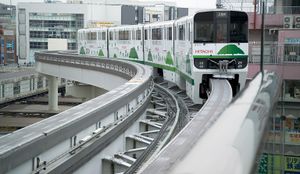
Japan has employed monorails in many cities, including:
- Chiba Urban Monorail (or Townliner) in Chiba, a satellite city of Tokyo
- Kitakyushu Monorail in Kokura, north Kyūshū
- Monkey Park Monorail Line which links the Monkey Park in Inuyama, Aichi prefecture to the nearest railway station
- Okinawa Monorail in Naha city, Okinawa
- Osaka Monorail
- Shonan Monorail in Kanagawa, in the southern outskirts of Tokyo
- SkyRail, a commuter line in a residential development suburb of Hiroshima
- Tama Toshi Monorail Line in Tama City in west Tokyo
- Tokyo Disney Resort Monorail
- Tokyo Monorail is the world's busiest and most commercially successful monorail line, carrying around 100 million passengers yearly.
- Ueno Zoo Monorail which links the two sectors of the zoo in Ueno park, again in Tokyo
Malaysia
- Kuala Lumpur Monorail - Kuala Lumpur, Malaysia
- Putrajaya Monorail - Putrajaya, Malaysia - Openning soon (No specific date)
- Sunway City Monorail - Sunway City, Petaling Jaya, Malaysia - It serves the Sunway city including Sunway Pyramid mall and Sunway Lagoon theme park and the surrounding. It is linked to KTM Komuter Station.
Singapore
- Sentosa, Singapore. Closed March, 2005. Replaced by a new larger-capacity monorail system that linked Sentosa with Singapore, the Sentosa Express in 2007
South Korea
- South Korea - Lotte World, two station amusement park monorail.
Europe
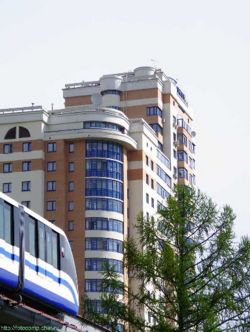
- Belgium: There are monorails in the Plopsaland and Bobbejaanland theme parks.
- Germany has a suspended monorail in Wuppertal, the Schwebebahn Wuppertal, dating back to 1901.
- Dresden's Schwebebahn uses a similar system.
- There is a smaller type of suspended Monorail (H-Bahn, "Hängebahn" or "hanging railway") at the campus of the university of Dortmund. This system is also used for the Düsseldorf SkyTrain, which operates at Düsseldorf International Airport.
- There is also the experimental Transrapid Maglev ("magnetic levitation") railway system built in Emsland. This prototype was subsequently developed by a German consortium into the world's first commercial Maglev railway: the Shanghai Maglev Train which runs from the Longyang Road station on the Shanghai Metro to to Shanghai's International Airport.
- Italy, Ravenna Amusement Park in Savio, 2 stations, 2 km.
- Netherlands There is a monorail located at the Slagharen amusement park and one located at Ouwehands Zoo.
- Moscow Monorail, Russia, partially open
- Listowel, Ireland was the site of the world's first commercial monorail, named the Lartigue system after Charles Lartigue who constructed this railway in 1888. A straddle-type monorail on a triangular beam, it was perhaps the only passenger monorail to also regularly carry freight and cattle. An historical recreation now exists and carries passengers as an entertainment.
- Kraków, Poland A monorail is planned for the city, with a grand opening ceremony in 2010. It will connect Airport, Downtown and Show place.
- The United Kingdom has monorail systems at Chester Zoo, Birmingham International Airport[2] and the Alton Towers and Blackpool Pleasure Beach theme parks. The first commercial monorail in the UK opened in 1962 at Butlins Skegness.
North America
Monorails can be found in the following places in North America:
- Walt Disney World in Orlando, Florida - The Walt Disney World Monorail System is one of the world's best-known monorail and serves over five million passengers yearly.
- Disneyland in Anaheim, California - The Disneyland Monorail System is known as the "First daily operating Monorail system in the Western Hemisphere."
- Seattle, Washington - short monorail (Seattle Center Monorail) built for the Century 21 Exposition in 1962
- Hershey, Pennsylvania - amusement monorail at Hersheypark.
- Lancaster, Pennsylvania - amusement monorail at Dutch Wonderland [1].
- Las Vegas, Nevada - public transit
- Memphis, Tennessee - a short monorail connects Mud Island in the Mississippi River to Memphis.
- Newark International Airport in Newark, New Jersey - people mover connecting terminals, parking lots, and to Amtrak/NJ Transit Northeast Corridor rail station
- Six Flags La Ronde in Montreal, Quebec - once part of a larger monorail systems built for Expo 67
- Minnesota Zoo in Apple Valley, Minnesota
- San Diego Wild Animal Park near Escondido, California. Five mile (eight km) long, one hour tour around the large area devoted to animal environments.
- Pearlridge Center in Aiea, HI, near Honolulu. The monorail is named "Skycab," and connects the Uptown part of the mall to the Downtown part of the mall. It is the only monorail system in Hawaii.
- Niles Monorail in Fremont, California. This a fully-operational, homebuilt, backyard monorail was constructed by monorail enthusiast, Kim Pedersen
- Dallas, Texas - Amusement ride at Dallas Zoo
- Miami MetroZoo, in Miami, Florida - Connects major exhibits at the zoo.
- JTA Skyway, in Jacksonville, Florida - Connects the main JTA bus terminal to the convention center and other downtown destinations, as well as a Park and ride garage.
South America
- Brazil has a monorail in Rio de Janeiro that links the large Barra shopping mall to its parking lot. Since 1990, a monorail has operated in Poços de Caldas, in Minas Gerais state. It has not been successful as a mass transit system, and nowadays is mostly used as a tourist attraction. It extends for 6 km, comprising 11 stations.
Brazil has a second monorail in the city of Pocos Do Caldes. This monorail is now decommissioned due to a failure in the track. The train sits on display at the station in the city center. [2]
Oceania
Australia
- Sydney, Australia has the Sydney Monorail originally designed as public transport but has found more use as a tourist attraction.
- The Gold Coast, Queensland has two monorails:
- A 2 km monorail around the Sea World Theme Park which was the first monorail in Australia.
- A link between Conrad Jupiters Casino and the nearby Oasis Shopping Centre in Broadbeach.
- Brisbane, Queensland once had a monorail, which was built for World Expo '88 and ran from the CBD across the river to Southbank. It was relocated to the Sea World Theme Park to form part of it's monorail system at the completion of Expo. Although the AirTrain is elevated and may look like a monorail, it is a conventional train line operated as part of the QR CityTrain heavy rail network.
Monorails under construction
Construction has started on the following monorails.
- Jakarta Monorail, Jakarta, Indonesia
- Putrajaya Monorail, Malaysia
- Palm Jumeirah Monorail, Dubai, UAE
Planned monorails
- Four separate times, voters in Seattle, Washington approved the construction a new monorail line up to 14 miles long to replace the Seattle Center Monorail. Although extensive planning had been done and land for the monorail's right of way had been acquired, the project was scrapped in a fifth public vote in November 2005, at a cost of several hundred million dollars. Unfortunately, the Seattle Monorail Commission depended on inaccurate revenue projections to fund the project.
- Extensions of the Las Vegas Strip monorail north to the city center and south to the airport are being planned.
- As part of the DestiNY USA project in Syracuse, a monorail from Syracuse University to Syracuse Hancock International Airport via downtown and the DestiNY complexes is planned.
- A 10-30 km (6-19 miles) monorail through the tourist district of Niagara Falls, Ontario is planned to replace the existing bus-based Niagara Parks Commission peoplemover system. The line will connect hotels and the road-based transportation network in the area to attractions such as Clifton Hill, Lundy's Lane, Casino Niagara, Niagara Fallsview Casino Resort, the Skylon Tower, Maid of the Mist and the falls itself.
- Brisbane, Australia.
- Tehran, Iran. Tehran Monorail.
- Kuala Lumpur, Malaysia, four new lines in addition to the current one: Petaling Jaya monorail, Subang Jaya monorail, Sungei Buloh monorail and Cheras monorail.
- Malacca Monorail,Malacca,Malaysia
- Penang Monorail, Malaysia
- Managua, Nicaragua
- West Kowloon Cultural District, Hong Kong, linking the WKCD with Tsim Sha Tsui
- Wellington, New Zealand [3]
- Goa, India
- Pune, Maharashtra, India
- JB Monorail in Johor Bahru, Malaysia
References
- ↑ Template:Cite website
- ↑ Birmingham Airport (BHX) (html). Retrieved on 2007-02-15.
See also
| Wikimedia Commons has media related to: Monorail |
- Louis Brennan
- Pod Monorail
- Public transport
- Personal rapid transit
- Transrapid
- Meigs Elevated Railway, an experimental monorail from 1886
- Gyro Monorail
- Monorail history
- Schwebebahn Wuppertal
- Marge vs. the Monorail - The Simpsons episode satirizing Monorail development
- Batman Begins - a monorail features as a prominent plot-point in the movie
- Transport Tycoon - a transport game which has monorails and a maglev system.
- Railroad
External links
Monorails in general
- The Monorail Society - home page of a volunteer organization promoting monorails, with separate pages on monorail switches and a backyard monorail
- Innovative Transportation Technologies - a website for the Transportation engineering and Urban planning programs at the University of Washington
Specific monorails
- Schwebebahn Monorail in Wuppertal, Germany
- Las Vegas Monorail
- Seattle Monorail - separately managed from the new Seattle Monorail Project (see also Seattle Monorail Blog)
- Sydney Metro - partly a monorail system
- Maglev Monorail - International Maglev Board
- Niles Monorail - Amateur built
- Walt Disney World's Monorail system
- nywf64.com (1964/1965 New York World's Fair Website) story of the AMF Monorail
Monorail advocacy groups
- Austin Monorail Project - a non-profit advocating monorail transit for Austin, TX
- 2045 Seattle - a grassroots movement that supports the construction of rapid transit monorail in Seattle, WA
Organizations/views opposing monorails
- Las Vegas Monorail: Troublesome Technology in a Unique "Niche" Application - a critical article on the Las Vegas Monorail from Light Rail Now!, a pro-light rail organization in Austin, TX opposed to monorails
- Monorail Capital Costs: Reality Check - a critical article on the capitial costs of monorails. From Light Rail Now!
- Monorails, Light Rail, and Automated vs. Non-Automated Transit Operation: Comparative Costs in Japan and USA - a critical article on the cost differences of monorails, whether they are automated or not. From Light Rail Now!
